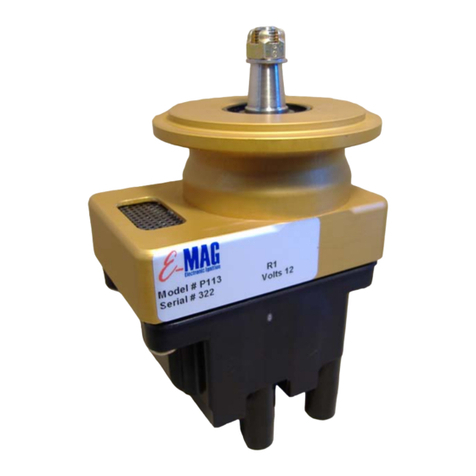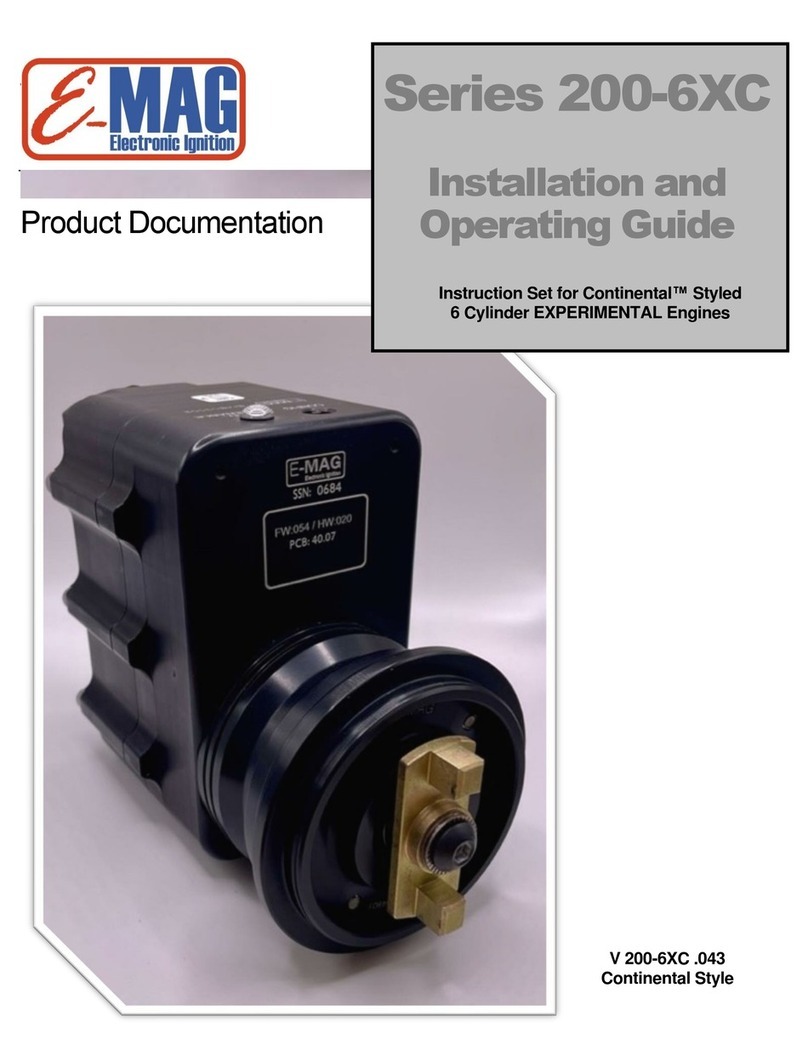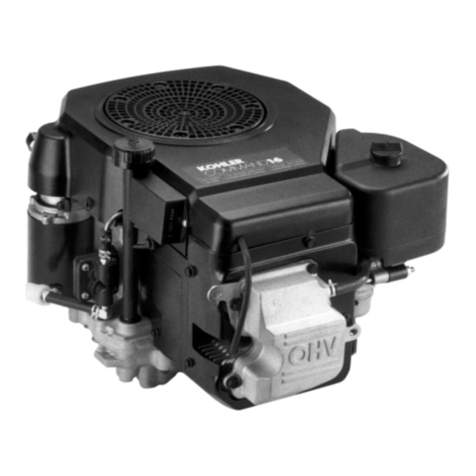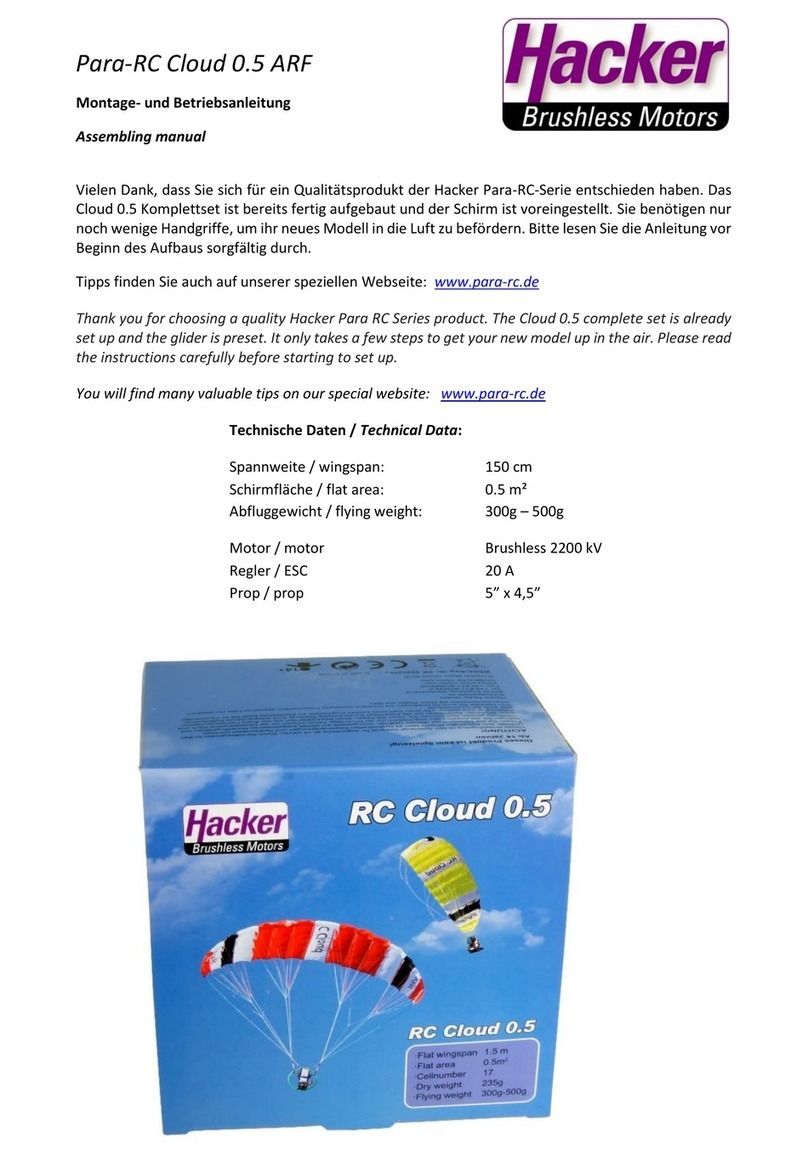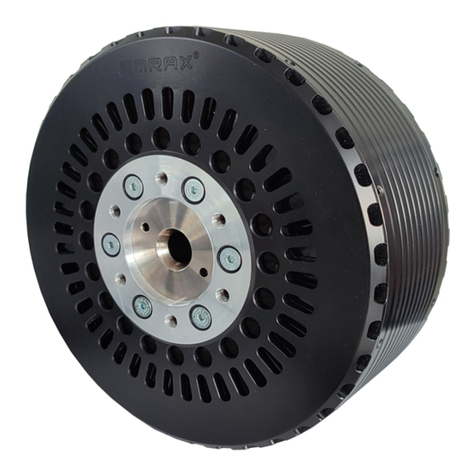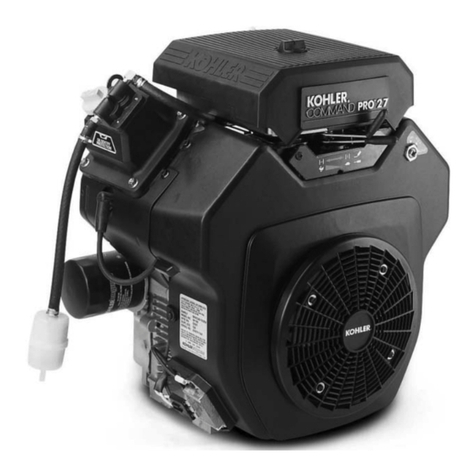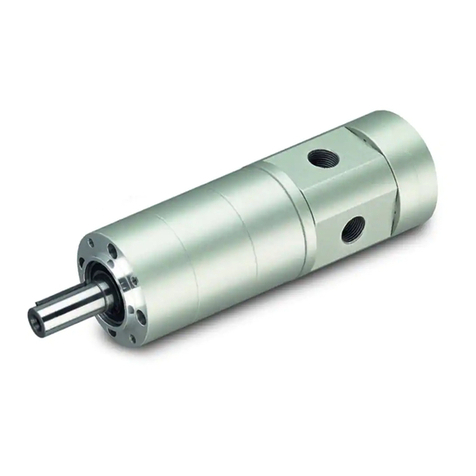E-MAG LYCOMING 200-6XL Series Installation guide

–+
Product Documentation
Instruction Set for Lycoming™Styled
6 Cylinder EXPERIMENTAL Engines
Series 200-6XL
Installation and
Operating Guide
V 200-6XL .041
LYCOMING™Style

1
Changes to Manual: Changes, corrections, and supplements may be made at any time (see version number on cover
page –bottom right). Refer to E-MAG’s web page “Downloads” for the most recent version.
Alerts and Service Notes: Prior to installation and operation, review all applicable Alerts and Service Notes affecting
your equipment. See E-MAG web site https://emagair.com/service-notes/.
Experimental Aircraft Only: Series 200-6X ignitions are not certified and are not approved for installation on certificated
aircraft.
Warranty: E-MAG electronic ignitions are warranted for one (1) year from the date of purchase. E-MAG will repair or
replace ignition modules within the warranty period that, in E-MAG’s sole opinion, have not been subjected to abuse or
attempted field repairs. This warranty is limited to the purchase price of E-MAG hardware and does not cover the engine
or other engine components that may be affected by defects or failure of the system. Do not attempt to open or separate
the ignition case sections. Doing so will void your ignition warranty.
CAUTION: The aircraft operator has the SOLE responsibility of determining how to appropriately and safely configure
and control engine and ignition operation. Nothing stated by E-MAG in this manual, its employees, owners, agents,
representatives, or affiliates should be construed as overriding or invalidating the engine manufacturer’s instructions.
E-MAG has NOT performed testing on the wide variety of engines in popular use and cannot offer specific advice as to
proper/suitable ignition configuration.
Notwithstanding engine manufacturer approval of certain engines to burn auto/alternative fuels, such endorsements
almost certainly presume operation with fixed magneto timing –and not variable firing electronic ignition. Operators
are SOLELY RESPONSIBILITY for independently verifying proper engine behavior with standard and/or alternative
fuels including the ignition setup AS CONFIGURED BY THE OPERATOR.
Markings:
•The letter “C” or “L” indicating a model compatible with most Continental™or Lycoming™style engines.
•Or a full model number ending with letter C or L indicating compatibility with most Continental™or Lycoming™
style engines
o200-6XC
o200-6XL
•Other part numbers may appear in the same area (disregard).
System Serial Number - is etched into the electronics case.
When ignitions are serviced by the factory, a Service Sticker (roughly ¾” x ¾”) will be added that shows currently
installed circuit board and firmware.
Copyright© E-MAG Ignitions, all rights reserved 2023.
2014 Greg Street, Suite 112, Azle, TX 76020
Phone (817) 444-5310

2
SHORT-CUT........................................................................................................................................4
INSTALLATION AND OPERATION...................................................................................................5
COCKPIT CONTROLS........................................................................................................................5
CONTROL PLUG WIRING..................................................................................................................6
SETUP AND CONTROL SWITCHES.................................................................................................7
LED AND TONE SIGNALS.................................................................................................................8
ENGINE ATTACHMENT.....................................................................................................................8
PLUG WIRES –CYLINDER ASSIGNMENTS...................................................................................9
AUTO PLUGS AND ADAPTERS.......................................................................................................9
MANIFOLD PRESSURE (MAP).......................................................................................................10
SETPOINTS.......................................................................................................................................11
SET IGNITION TIMING......................................................................................................................11
PULL -THRU TEST ...........................................................................................................................14
TUNING MAX.....................................................................................................................................15
OPERATING NOTES........................................................................................................................16
MAINTENANCE.................................................................................................................................18
WIRING DIAGRAM............................................................................................................................20
APPENDIX 1 –SPARK PLUGS & ADAPTERS..............................................................................22
APPENDIX 2 –ENGINE TC LOCATOR ..........................................................................................23
APPENDIX 3 –TACH ELECTRICAL SPECIFICATIONS...............................................................24
APPENDIX 4 - INSTALLATION CHECKLIST .................................................................................25
APPENDIX 5: HARNESS FABRICATION (LEADS).......................................................................27

3
Using This Manual
This manual will include supplemental notes, comments, and tips that will appear as blue text.
Different versions of this manual are available for Lycoming™style and Continental™style
engines. Both versionscan be downloaded from the E-MAG web site.
Lycoming™is a registered trademark of Avco Corporation.
Continental™is a registered trademark of Continental Aerospace Technologies™.
Exercise care when handling the ignitions, engine, or propeller. There is a significant risk of burn,
electrical shock, injury, or even death. This manual may offer safety suggestions, but it is NOT to
be considered a complete list of the potential hazards, NOR is it presented as a complete set of
safety precautions that should be followed.
RISK OF EQUIPMENT DAMAGE: [***IMPORTANT***] Firing the ignition without all high voltage
loops in place, risks damaging the coils and/or electrical shock to the handler. If incurred, such
damage may not be immediately evident. High voltage loops include the circuit from a given coil
tower, to plug wire, to plug,to engine block, to companion plug, to companion plug wire, to
companion coil tower. Each pair of cylinders (1&2, 3&4, 5&6) constitutes a separate high voltage
loop.
ID
Date
Summary of Principal Changes
V 200-6X.31
5/25/19
Initial Product Release - disregard all previous materials.
Note: This ignition version includes two operating modes (fixed and variable
firing). Both modes share common position and processer-based control
logic elements. Redundancy is provided by having two autonomous (left/right)
ignitions, and up to three sources of operating power. Experimental versions
DO NOT have discrete logic circuitry for each mode.
V 200-6X.38
10/28/19
Simplified Setup procedure.
Simplified DIR check and DIR change instructions.
MAX factory default now 9 degrees ahead of MIN.
Lycoming and Continental engine types now have separate instruction sets.
Added Quick-Start overview for re-installing.
Numerous other changes.
V 200-6X.39
11/12/19
Added option for straight spark plug boots/terminals if needed –primarily for
lower plugs on some Continental engines.
Added key parts to confirm prior to installation –see Quick-Start.
Reduced many of the required control wire sizes.
Revised starting instructions.
V 200-6X.40
7/28/20
LR spark plug number - Denso Spark Plug IKH27 (stock #5347)
Mode Switch (optional for normally aspirated engines –1K resistors are pre-
installed in the factory switch
Revised routine for changing ignition direction (DIR)

4
V 200-6X.40
12/1/21
Engine performance mods (compression, induction, fuels, etc) might lower
your target MIN and MAX settings.
V 200-6X.41
4/25/23
Suggestion for long primary battery cable runs (RV10s, canards, others).
Clarify: Pull-Thru test verifies bank firing order only. Cannot be used to check
tracking accuracy.
Revised wiring schematic
Firmware V55 and afterenables Fixed Mode starting, increased spark energy,
Fixed Mode fires at MIN vs previous version Fixed Mode firing at default 20.
Factory default MIN will be between 20 and 22 degrees.
FW V58 improves transitions from external power off to power on.
Manual sections have been reorganized to better followinstallation flow.
Short-Cut
Abbreviated Overview.New installers should review the entire manual.
NOTE: Most Lycoming™styled engines rotate clockwise (viewed from back of the engine - looking
at prop on the far side). Series 200 6XL ignitions come pre-configured for this direction. If your
engine rotation is different (i.e. for a twin) you can easily change ignition direction (DIR). Confirm
proper DIR setting by watching the power-up Color-Burst. In the first ½ second the LED sequence
will end with a flash of WHITE followed by RED or GREEN, and then resume normal LED
signaling. Most Lycoming™styled engines will look for a White/RED Color-Burst (clockwise
rotation signal).
Prior to installation, make sure you have the following items identified and on-hand.
•Suitable size ignition mounting studs and clamps –see Engine Attachment and Appendix 4.
•Fittings needed to connect ignition manifold pressure to your induction system see Manifold
Pressure (MAP).
•Identify your 14/28/48-volt power connection, fuse or circuit breaker, and power test switch
requirements –see Control Plug, Cockpit Controls, Wiring Diagram.
•Wire the Control Plug but don’t connect to ignition until instructed.
•Suitable automotive spark plugs –see Appendix 1.
1) Mount Ignition: Insert the ignition(s) at any convenient orientation and tighten mounting clamps
to 17 ft/lb. Verify bus power and kill switches are both OFF, then connect the Control Plug.
2) TC Setpoint: - see Setup
a) Move engine to flywheel TC mark. Press/hold the Config Button while you turn bus power
ON –Note 1. Continue hold until LED turns BLUE - then release. LED will start blinking
BLUE/GREEN.
b) Press/hold Button again (for several seconds) until LED briefly flashes WHITE - release. TC
is now stored. Ignition will automatically reboot in normal mode and settle at YELLOW LED
with tone (i.e. TC position).
3) Check or Change MIN and MAX: Move prop to MIN and MAX positions (see Note 2) to
confirm or adjust as appropriate (see Setpoints and Setup):

5
a) MIN (BLUE LED) matches engine manufacturers recommended magneto firing angle.
b) MAX (WHITE LED) marks the maximum cruise firing angle. Default MAX is 9-degrees
before MIN.
4) Basic Setup is complete. Finish installing plugs and plug wires, MAP plumbing, blast tube
cooling, and do the Pull-Thru test. See details for each later in the manual.
Note 1: TIP if installing alone. It may be difficult to press/hold the Config Button and, at the same
time, reach the power switch. Disconnect the Control Plug, then turn bus power ON, then
press/hold the button while you re-connect the Control Plug (i.e., turn bus power ON).
Note 2: While checking MIN and MAX setpoints you will notice the ignition sounding a tone signal
at the 20 and 25-degree positions. These are fixed reference aids only. They do not follow your
stored (movable) MIN or MAX positions. MIN and MAX are identified by the LED (BLUE/WHITE)
only.
Installation and Operation
Cockpit Controls
1) Circuit breakeror fuse (one per ignition).
2) Ignition kill switch (p-lead) can be either:
a) Rotary switch OFF/R/L/Both/Start.
b) Toggle switch UP/ON and DOWN/OFF.
3) Ignition power test switch (Note 1) is for testing ignition internal alternator –see Ignition Checks:
a) Ramp Checks - a basic ignition alternator check.
a) Cut-Out test –a stress test for ignition alternator and the overall system to determine the
low-speed operating boundary. Should be done after installation, annual check, and after
major maintenance.
4) Mode Switch FIX/VAR:
a) Required on all boosted engines.
b) It is optional on non-boosted engines - see wiring diagram at end of manual.
Note 1: The internal alternator power test circuits can be configured several ways and is largely a
matter of builder preference. That said, the two controls involved (kill switch and power test switch)
can be located next to each otheron the panel, making these tests one-handed, intuitive, and more
ergonomic. Two examples are shown below the Wiring Diagram at the end of this manual.

6
Circular plug (ignition)
Circular plug (cable)
Control Plug Wiring
1) Plug styles:
a) Standard circular Mil plug connector (PT06A-10-6S-SR or equivalent). This is a solder
connection style plug with built-in strain relief clamp for attaching (20 AWG) control wires.
Note: Standard plug is roughly ½” longer than the optional potted plug (below) - if case
clearance is tight.
b) Optional circular plug connector with pig tail –circular connector (PT06P-10-6S or
equivalent) with 96” of color-coded wire soldered and potted –see color references below
and wiring schematic at the end of the manual.
2) Pinouts:
a) Pin “A” on circular plug (Pig-Tail red wire) - connects to your 14, 28, or 48-volt aircraft bus
–20 AWG. See Note 8. Route through a power test switch and suitable circuit protection.
Possibilities are:
i) A 5-amp fuse and separate power test switch.
ii) A 5-amp switchable circuit breaker, which can satisfy circuit protection and power test
duties.
b) Pin “B” (Pig-Tail black wire) - connects to the cockpit panel ground –20 AWG.
c) Pins “C” and ”D” (Pig-Tail not populated) –for future use.
d) Pin “E” (Pig-Tail yellow wire) - connects to your cockpit kill switch (p-lead ignition
ON/OFF). To turn ignition OFF, ground the p-lead with the switch. To turn ignition ON, un-
ground the p-lead Switch (*) 22 AWG.
e) Pin “F” (Pig-Tail blue wire) –connects to tach instrument (3 pulses per rev) 22 AWG.
(*) Mode Switch (optional): Ignitions can work with a
cockpit switch to select either Fixed Mode or Variable
Mode operation. The switch circuit addsa 1K bias
signal to the existing killwire (pin E) to enable Fixed
Mode operation. The switch E-MAG offers is a SPDT
(one switch controls two ignitions) with 1K resistors pre-
installed. Mode Switch is optional on normally aspirated
engines but is required on boosted engines.
Note 1: CAUTION] Shower or vibrator type starting aids are not compatible and may damage
your E-MAG –remove before installation.
Note 2: E-MAG p-lead wire does not make radio noise and does not require shielding. If replacing
a magneto, your existing shielded p-lead wire can be re-used. If doing so, the outer shield needs to
be trimmed clean and kept well clear of all otherterminations.
Note 3: All E-MAGs are “starting ignitions”. In a dual installation, or if replacing a non-starting
magneto, revise your starting procedures, and/or remove any key switch starting blocks (remove
the jumper on the backof the key switch) to your E-MAGs.
Note 4: Whenever the aircraft bus is powered ON, the ignition is “awake”. It draws a small amount
of current (approx. 40 milliamps) even when not firing plugs. Use the master bus switch (or

7
breakers if necessary) to power down the ignitions when not in use.
Note 5: Do not power the ignition ON when you have a ground battery charger connected to the
bus. Pulling the breaker will isolate the ignition when charging.
Note 6: Collect your tach signal from only one ignition unless your instrument has provisions for
two (separate) tach inputs. Unlike a magneto, E-MAGs produce a tach signal even when kill switch
is turned to OFF.
Note 7: Tach signal is a 3 pulse/rev, low true, 33% duty cycle, 10 to12-volt pulse - see Appendix 3.
E-MAG’s tach output is a courtesy feature, unrelated to the ignition’s primary purpose. Due to the
variety of instrument options available, our ability to support and troubleshoot interface issues is
limited.
Note 8: Longer cable runs to a remote main battery* may need to access bus power through a
dedicated 16 AWG cable connected directly to the battery.This will avoid sharing a long power
cable with the starter motor, a combination that can exaggerate power dips during startup and
inhibit ignition operation when cranking.
*Typical in RV10s, some canards, and others.
Setup and Control Switches
1) Configuration Button (“Button”) is located beneath a black plastic screw cap on the end face
of the ignition. The Button isused to set TC, move MIN/MAX setpoints, or change ignition DIR.
2) Mode Switch (optional) –Fixed Mode orVariable Mode can be selected by a single cockpit
Mode Switch that directs both left and right (Series 200) ignitions. Fixed Mode is enabled when
the Mode Switch applies a 1K bias resistance to the kill (p-lead) circuit(s). The Mode Switch
can serve one or two (Series 200) ignitions. The Mode Switch is required for all boosted
engines. For non-boosted engines the Mode Switch can be eliminated, in which case the
ignition will operate in Variable Mode only.
a) Fixed Mode - Mode Switch “FIX” will fire plugs at the MIN firing position. RPM must be
above cranking speeds–i.e. you cannot start in Fixed Mode. [In FW V55 and after, Fixed
Mode starting is enabled]
b) Variable Mode - Mode Switch “VAR” allows RPM and MAP inputs to select a plug firing
position between the MIN and MAX boundaries.
3) Power Test Switch - A cockpit bus power interrupt switch is used to test the ignition internal
alternator. A switchable circuit breaker or separate test switch can perform this function. –see
Wiring Diagram
4) Kill Switch (p-lead switch) - The traditional cockpit ignition ON/OFF (Left/Right) Kill Switch is
unchanged. The Mode Switch does not interfere or alter Kill Switch operation. The Kill Switch
OFF position connects the E-MAG kill wire (p-lead) to ground. The ON position un-groundsthe
kill wire. Note: All connections from previous installations (tach, shower of sparks, etc.) must be
removed from kill switch wiring.

8
FIX/MIN (blue)
Background
LED color is
GREEN.
MAX (white)
Orientation will flip for
installations rotating in
opposite direction
(DIR).
Fig A
TC (yellow/tone)
Tone Positions:
Tone with yellow
LED at TC.
Tone (no LED) at 20
and 25-degrees,
serving as a general
position reference.
LED and Tone Signals
1) RED LED indicates CAUTION. When ignition
is powered ON and killswitch (p-lead) is ON the
unit is capable of firing plugs (“HOT”).
a) Steady RED indicates Variable Mode HOT.
b) Blinking RED indicatesFixed Mode HOT.
2) Other LED colors are enabled byturning kill
switch to OFF (groundp-lead). Plug firing is
blocked when displaying other colors.
a) Background color is GREEN.
b) Setpoints:
i) YELLOW* (with tone) signals ignition TC
setpoint.
ii) BLUE signals MIN setpoint, the lower end
of the firing range in Variable Mode or the fixed firing position in Fixed Mode.
iii) WHITE signals MAX setpoint, the upper end of the Variable Mode firing range.
3) Tones will sound at:
a) The stored ignition TC position (with YELLOW LED).
b) Ignition 20 and 25-degree positions. Tones are for the sole purpose of helping installers
locate their chosen MIN and MAX setpoints. After setting TC, these tones will flag the 20
and 25-degree positions –see Fig A. Other positions (18, 22, 35, etc.), if needed, can be
interpolated from these fixed reference locations.
* YELLOW is a composite color where two LED elements produce a dull and slight shimmering
yellow effect (a limitation of this style LED).
Engine Attachment
First, verify the studs and clamps on hand are compatible
with the E-MAG flange. E-MAG flange is 0.19” thick - not
compatible with 0.31” clamps common with certain
magnetos. Remove magneto spacers (highlighted area in
photo) and long studs. Long studsare identified by the
roughly 1.75” of exposed stud. Replace with short studs
(#31C12) that will have roughly .75” of exposed stud when
installed. Ignitions will be secured by:
1) Two studs - one above and one below each ignition
station.
2) Mounting clamps will fit overeach stud and secure the ignition flange (with fiber gasket) to the
case - see Setup below.

9
Lycoming™styled engines:
1) Always - route Bank A to cylinders 1&2.
2) Most will route Bank B to 3&4, Bank C to 5&6 as shown.
3) In the event of a Left*(CCW) rotating engine, routeBanks
B to 5&6 and C to 3&4.
Always verify proper firing with the Pull-Thru test.
Tip: Penetrating oil and heating the case area around the studs with a heat-gun can make stud
removal and replacement much easier. (Remove rubber cushions before using heat gun.)
Plug Wires –Cylinder Assignments
As with any wasted-spark ignition, E-MAGs fire spark plugs in pairs. Cylinders 1&2, 3&4, 5&6 are
pairs with plug leads connected to both ends of a double ended coil “Bank”. See Appendix 5 for
instructions on fabricating individual trim-to-fit plug wires.
.
Note 1: The Pull-Thru test [highly recommended] is the best way to verify the installation follows
correct bank (cylinderpair) firing order. This test uses encoder data at the lowest possible
resolution, i.e., pull-thru firing positions cannot be used to check tracking accuracy. During
normal operation, dynamic quadrature counters are used to increase tracking resolution and
accuracy.
Note 2: Ignition Bank firing sequence is A-B-C regardless of the direction of the engine/ignition drive
interface.
Note 3: * CW and CCW engine rotation reference –as viewed from back of engine looking to prop
on the far side.
Note 4: If using strap (Adel) clamps to secure plug leads, make sure the clamps are properly sized.
Reusing clamps for smaller size (previous 7mm aviation leads) wire may be too tight and
crush/compromise the internal silicone insulation layer of our 8mm wire.
Auto Plugs and Adapters
Aircraft engines are typically tapped for 18mm spark plug threads. To use 14mm automotive style
plugs, E-MAG can provide auto plug adapters. There are numerous auto spark plug styles and
temperature ranges available through various outlets. E-MAG has NOT studied the relative
durability or performance of different plug brands and styles. Customers need to monitor plug
condition and evaluate and adjust as necessary. The plugs listed in Appendix A and have a history
of good service. Set plug gaps at 0.030” to 0.035”.
Bank A
Bank B
Bank C
1
2
3
4
5
6

10
Long Reach (LR) vs. Short Reach (SR) Cylinders
Cylinders are made with two different spark plug thread depths. Match
spark plugs and plug adapters (LR or SR) to the cylinder depth when
ordering.
1) LR orSR cylinders can be identified by the aircraft spark plug call-out
for your engine. If it has the letter “M” - as in REMXXX, you will need SR
plugs and adapters. If it has the letter “B” as in REBXXX, you will need LR plugs and adapters.
The plug call-out can be:
a) Read directly from the side of yourold aircraft style plugs.
b) Found on an aviation spark plug replacement chart.
2) Cylinder thread depth can also be measured directly, which identifies the correct adapter:
a) Short Reach (“SR”) adapters have external thread length of approx. 1/2”.
b) Long Reach (“LR”) adapters have external thread length of approx. 3/4”
Spark Plugs - See Appendix 1 for specific spark plug recommendations.
IMPORTANT:Remember to FIRST install each spark plug in the adapter (fully seated and finger
tight). THEN, insert the combined plug/adapter assembly in the engine and tighten to 18 ft/lb.
(standard auto plug torque) through the spark plug ONLY. Do NOT torque the adapter itself. If
you torque the adapters directly, stress will be focused underneath the adapter head and it can fail
during installation. Such failures are not covered under warranty. Use anti-seize (sparingly) on the
outer/engine side of adapters. Auto plug manufacturers do not recommend anti-seize on their
plugs.
Manifold Pressure (MAP)
The ignition comes with 3’ of 1/8”x1/4” silicone tubing and a 1/8”
barbed nipple to 1/8” NPT brass fitting (packed separately) for use in
connecting manifold pressure. You could also use the female 1/8” NPT
in the ignition to attach your own larger MAP hardware if preferred.
The ignition has both electronic and mechanical MAP pulse
dampening built in. With normally aspirated engines, the MAP tube
is a fail-safe input. Meaning if the MAP plumbing fails, plug firing in
Variable Mode will automatically retard to a flyable, but slightly less
efficient, firing position. If installing two ignitions, run a single MAP
tube to the accessory area, and then tee the MAP line to reach each ignition. If you already have a
manifold pressure gauge, tee into that existing line for your pressure source.
With turbo normalized or boosted engines, MAP plumbing is NOT considered fail-safe. A MAP
plumbing failure can, in certain conditions, call for more ignition advance than is appropriate or safe.
Excess advance can result in lossof power, overheating, and/or damage to the engine. For this
reason:
1) The MAP plumbing for two ignitions should be separate, so a plumbing failure on one side
would affect only one –not both ignitions.
SR LR LRX
LRX
MAP-1/8” Barb
(shown) or 1/8
NPT if brass fitting
is removed.

11
2) The cockpit Mode Switch (required forboosted engines) provides a simple manual override
that puts both ignitions in Fixed Mode, where MAP input is not a factor –see Mode Switch
elsewhere in this manual.
Note: All Lycoming™cylinders have a primer port that can be used to access manifold pressure.
Use a standard 1/8” NPT fitting with 3 or more inches of metal primer tubing as a heat barrier
before transitioning to the MAP tubing included. The 1/8” NPT to 1/8” barb fitting in your incidental
kit is for attachments at the ignition only. This fitting, alone, will not provide a suitable heat barrier
for tubing attachment at the cylinder primer port.
Setpoints
(Reference drawing Fig A)
1) TC (YELLOW LED - with audible tone) signals the ignition top center position.
2) MIN (BLUE LED) –A firing reference installerswill set to match engine mfg. recommended
(magneto)firing angle - typically 20 to 25 degrees before top center:
a) Marks the low advance (high power) end of the firing range in Variable Mode.
b) Also marks the fixed firing position in Fixed Mode (if optional Mode Switch is installed).
3) MAX (WHITE LED) –A firing reference that marks the high advance (cruise power) end of the
Variable Mode firing range. The default setting for MAX is 9 degrees ahead of MIN. Can be set
anywhere between 6 and 9-degrees before MIN.
4) DIR (not a setpoint per-se) –The ignition’s current operating direction (DIR) is displayed by
various means throughout the installation process. (i.e. if it’s wrong the system will catch it
later.)
Note 1: Anytime you move a TC, MIN, or MAX setpoint, reconfirm the stored setpoint positions of
all three. Some changes will restore the original factory default (override the custom setting you
last made). Setpoints should be stored in order –TC, then MIN, then MAX as shown
throughout the manual.
Set Ignition Timing
Direction (DIR) Checks: Ignitions from the factory will come pre-configured for
the most common rotation direction (DIR), but it still needs to be confirmed. DIR
is checked at several points during the Setup process and is easy to change
when/if needed. The first opportunity to check DIR is prior to insertion.Look
directly into the vacant accessory case ignition drive opening while turning the
prop in the normal direction. If the ignition drive socket turns:
•Clockwise - you have a RED engine (DIR color). Lycoming engines are RED
engines, unless you have a left rotating engine for a twin (a GREEN engine).
•Counterclockwise - you have a GREEN engine (DIR color).
1) Mount Ignition: Verify bus power is OFF and Kill Switch is OFF (grounded).
Turn ignition rotor by hand to align rotor lugs with rubber cushions (cushions not shown in
photo) in the ignition drive socket. Insert the ignition (with gasket) and secure mounting clamps

12
finger tight. Rotate the ignition to anyconvenient orientation and then alternately tighten
mounting clamp nuts to 17 ft/lb.
2) DIR Color-Burst: Verify bus power and Kill Switches are both OFF. Connect the ignition
circular Control Plug and then turn bus power ON. LED will provide a Color-Burst sequence (in
the first ½ second) that ends with WHITE, followed by either RED or GREEN, and then
transition to normal color signals (see Note 2). Turn bus power OFF. RED engines (i.e. most
Lycoming™) will look for a white/RED color-burst sequence.GREEN engines will look for a
white/GREEN color-burst sequence. If the DIR Color-Burst matches your engine - proceed to
Step 3. If it doesn’t, you need to change DIR - see Note 1 below.
3) TC Setpoint:
a) Flywheel TC method - Lycoming™styled engines have marks on the flywheel to easily
locate engine TC. When using this method:
i) Verify power and kill switchesare both OFF. Move engine to flywheel TC, (compression
on #1 or #2 cylinder –does not matter) where it will remain until Step 4. (see Note 4)
ii) Press/hold the Button while you turn bus power ON. Continue the hold for several
seconds until LED turns BLUE –release Button. LED will be BLUE with a periodic
GREEN pulse.
iii) Then press/hold the Button again (several seconds) until the LED flashes WHITE -
release Button. TC is now stored, and the ignition will automatically re-start in normal
mode. The LED will settle at steady YELLOW (with tone), indicating the ignition is
setting at the newly stored TCposition. Proceed to Step 4.
b) TC Locator method: If preferred, installers can use TC Locator to locate and store TC –
see Appendix 2.
4) MIN (BLUE) and MAX (WHITE) setpoints:
a) Check setpoints by positioning prop (engine) tothe MIN and then the MAX positions.
Approaching setpoint positions with engine moving in the normal direction may help to
reduce gear lash.
i) Confirm the MIN(BLUE) setpoint matches the engine manufacturers recommended
magneto firing angle. NOTE: Engine alterations that boost power (high-compression
pistons, induction mods, custom cams, enhanced fuels, etc. may require more
conservative (lower) MIN and MAX settings. The ignition default MIN is around 20 to
22-degrees before TC. Adjust as needed.
ii) MAX(WHITE) The ignition default MAX is 9-degrees ahead of MIN and can be re-set as
low as 6-degrees ahead of MIN.
b) Change setpoint positions (if needed) –see Note 5:
i) With the intended setpoint color showing (BLUE example) press/hold the Button.
ii) Continue the hold while you move the prop (engine) to the desired setpoint location.
iii) Then release the Button. The setpoint color will remain (BLUE example), indicating
placement at the newly stored setpoint.
iv) Setpoint changes need to be made in order –TC, then MIN, and then MAX.
5) Basic setup is complete. Always confirm setpoints by slowly rocking the prop back and forth
over:
a) TC (flywheelmark) Setpoint to see GREEN - YELLOW (with tone) - GREEN

13
b) MIN Setpoint to see GREEN - BLUE –GREEN –see Note 1.
c) MAX Setpoint to see GREEN - WHITE –GREEN–see Note 1.
Prior to operation you need to connect plugs and plug wires, manifold pressure (MAP)
plumbing, and blast tube cooling –as appropriate. We also recommend doing a Pull-Thru test.
Details for each can be found elsewhere in manual.
Note 1: After Setup, correct DIR setting isre-confirmed by:
•Engine movement in the region before TC will produce MIN (BLUE) and MAX (WHITE) LED
signals as well as tone sounds at 20 and 25-degrees (reference tones). If instead, they appear
in a similar region after TC your DIR is set for the wrong direction. Correct by following
(Change DIR) steps below.
•The Pull-Thru test (highly recommended) will fire plugs only when engine is pulled thru in the
programmed direction (DIR). Plugs will not fire if the engine is pulled in the wrong program
direction. Correct by changing ignition DIR.
Change DIR
•(Firmware V52 and after) Position ignition at TC (YELLOWLED with tone), then press and
hold Button for 6 or more seconds. The LED will flash red during the hold, then flash
WHITE (release Button), then automatically re-start with a color-burst (look for WHITE then
RED or GREEN) that signals the new DIR setting. Changing DIR will restore factory
default MIN, MAX, and TC settings. Return to Setup Step 3.
•(Firmware prior to V52) With a steadyGREENLED showing (normal background color),
press/hold Button for 10 seconds until the LED turns WHITE –release Button. Ignition will
store the change and re-start with a color-burst (WHITE then RED or GREEN) that signals
the new DIR setting. Changing DIR will restore factory default MIN, MAX, and TC
settings. Turn bus power OFF and return to Setup Step 3
Note 2: Make sure Kill Switch stays OFF until all high-voltage connections (plugs, plug-wires, coil)
are in place. Firing plugs without all high-voltage connections risks damaging the coil. After the
initial Color Burst at power-up, a continuous RED LED (flashing or steady) indicates ignition is
ON/HOT (ready to fire plugs). No Setup procedure requires ignition to be HOT. Power OFF
and examine/correct kill circuit.
Note 3: Take care with the rubber drive socket cushions when removing or inserting the ignition. If
they drop into the accessory case, retrieval can be problematic.
Note 4: There are two sets of flywheel marks. Marks on the prop side of the flywheel align with a
pinhole reference in the starter motor case. Marks on the engine side of the flywheel use the upper
engine case seem as a reference. Don’t align the flywheel marks with the wrong reference.
Note 5: Moving MIN or MAX Setpoints. The procedure for moving a MIN or MAX setpoint is simple
but strict in two respects:
•Make certain the Button press/hold is started with the setpoint color showing (BLUE or
WHITE), i.e. not the background GREEN color.
•The Button “hold” must be uninterrupted until you reach the new engine position. If the
button hold is relaxed in route, the setpoint will attach to an unintended release point.

14
Blast target
Blast Tube Cooling
E-MAGs are designed for a high-heat environment, but there are still
thermal limitations and benefits to keeping the equipment as cool as
possible. Blast tube cooling is a simple way to reduce operating
temperatures, and we consider them mandatory. Blast tubes should
be directed at the round neck, immediately behind the mounting
flange.
The mere presence of blast-tubes does not guarantee they are
operable and/or effective. After initial operations, operators can verify
the ignitions are within temperature guidelines (under 200F during
flight). A thermal reactive label is installed on the electronics case.
Alternatively, a thermal probe can verify ignition case temperatures at
the forward section of the electronics (box shaped) compartment.
Electrical System Condition
E-MAG’s power dip protection helps guard against severe voltage
drops that occur when the starter motor is engaged. However, in the event of a compromised
electrical system (low battery, long cable runs,undersized cable, corroded terminals, cold engine,
etc.) bus voltage may not rebound as the starter speeds up (as is normal). A properly designed
and functioning electrical system is essential for the ignition to work properly. If bus voltage drops
below a certain level while cranking, a safety circuit may prohibit the ignition from firing. The starter
motor pulls the largest load on the electrical bus. Keeping non-essential loads turned OFF while
cranking will help.Note: We have no definitive guidance, but there is some indication light-weight
lithium batteries may contribute to greater ignition voltage dips during startup.
Pull -Thru Test
The Pull-Thru test will confirm 1) plug wire assignments, 2) basic operation of firing circuits, and 3)
correct DIR as follows:
1. Remove all spark plugsfrom the engine and reconnect them to the plug leads.
2. *IMPORTANT* Rest each plug on the engine case or convenient location such that the
metal jacket of each plug is grounded to the engine block. Alternatively, the plug metal
jackets can be wired to the engine block or plugs can be bundled directly to each other with
metal jackets in direct contact of each other.
3. One ignition at a time: Turn bus power ON, Kill Switch ON, and (if installed) Mode Switch to
VAR. LED will be steady RED. Rotate the prop by hand in the normaldirection of travel
and confirm all plug pairs fire in proper sequence. Any deviation indicates a wiring or setup
error.
•Both plugs for cylinders 1&2 (Bank A) fire at the starting lag position (roughly 4-degrees
after TC).
•Both plugs for Bank B fire 120 degrees later –see Note 3.
•Both plugs for Bank C fire 240 degrees later –see Note 3.
Note 1: Plugs will not fire:

15
i) When the engine is rotated the wrong direction.
ii) If ignition DIR does not match engine rotation.
iii) When Mode Switch is in FIX position and engine is moving at hand pull-thru speeds.
iv) Plugs fire only once percycle. You cannot backup and fire them again. Keep pulling thru
in the normal direction.
Note 2: Multi-Strike. At cranking speeds, the ignition uses a (5) rapid strike sequence for each
bank. This means the Pull-Thu Test will not produce the familiar single spark “click”. Instead, you’ll
hear the plugs “buzz” - the sound of a multi-strike sequence.
Note 3: Due to the variety of engine and ignition configurations, it maybe necessary to swap the
plug wire to cylinder (Banks B and C)assignments to achieve proper firing –per the engine
manufacturer firing order.
Note 4: Pull-Thru firing positions cannot be used to verify ignition tracking accuracy. It only confirms
proper wiring and circuit assignments.
Tuning MAX
Orientation:
Operating the ignition in Variable Mode (Mode Switch “VAR”) can improve engine efficiency by
enabling automatic adjustment of the plug firing advance. The range of automatic adjustment is
capped by the MAX setting. MAX will be either the default (9-degreesahead), or a lesser MAX
position (as low as 6-degrees ahead) as set by the operator. The default MAX setting is thought to
be a relatively conservative setting, especially when a Mode Switch installed, and the operator can
change to Fixed Mode at any time.
Operators can monitor VAR mode cruise conditions (RPM above 2400 and MAP 22” or below)
where spark advance is greatest and be mindful of the engine manufacturer’s temperature
recommendations and red lines. It should be understood that improving efficiency (extracting more
energy from a given amount of fuel) means a certain amount of additional heat may be generated.
Operators can anticipate VAR mode advanced firing will cause CHTs to rise by some increment
and EGTs to fall by some increment.
As a GENERAL FRAMEWORK ONLY, tuning VARmode operations (MAX adjustments) can be
guided by engine efficiencies (airspeed/fuel-flow) and CHTs at cruise power settings –keeping in
mind the limitations of CHT readings. Ignition advance is a significant, but not the only factor
influencing CHTs. Baffling, mixture, prop, cylinder design, cylinder break-in, air temperature, air
density, humidity, fuel type, induction boost, and more can all affect the indicated CHT. Every
installation should be considered unique –assume nothing.
Establish a baseline
An initial period of operation in Fixed Mode (Mode Switch to “FIX”after start-up) will allow youto
establish an operating baseline with plug firing at the manufacturer’s recommended (magneto)
firing position. Similarly, Variable Mode operation at high power (higher RPM and MAP 25” and

16
above) settings will fire at the same MIN/magneto position. The ignition will still provide higher spark
energy and that alone will have some effect on behavior. If temperature issues are encountered
under these conditions you might test with a slight reduction of MIN firing position, or look into
corrections outside the ignition –baffling, fuel, etc.
Tuning Actions –Adjust MAX setpoint (affecting Variable Mode only)
1) Extending MAX past the 9-degree default will have little, if any, beneficial effect. The underlying
advance table itself (initial release models) is limited to 9-degrees. The ignition may reject
attempts to set MAX past that point.
2) Restricting MAX (move closer to MIN) will lower the advance range which should reduce
excessive cruise CHTs –if encountered. MAX can be set aslow as 6-degrees before MIN.
Tuning Objectives:
The goal is not to deploy the maximum amount of ignition advance possible. Rather, we’re looking
for the least aggressive setting that maximize performance - and no more. Overly aggressive
settings don’t improve performance but can increase temps and potentially damage the engine.
Adjust accordingly.
Note 1: Mode Switch - When you enable Variable Mode (Mode Switch “VAR”) to test MAX settings,
you always have the option of switching to Fixed Mode (Mode Switch “FIX”) and return to your
previously established fixed firing baseline. The Mode Switch can be operated at any time, other
than startup, when Variable Mode is required.
Note 2: Alternative (auto) Fuels: CAUTION - Notwithstanding engine manufacturer approval of
some engines to burn auto/alternative fuels, such approvals almost certainlypresume operation
with fixed magneto firing - not high-energy variable firing electronic ignition. Operators need to
independentlyvalidate proper engine behavior with different fuels and adjust ignition as needed.
Generally speaking, auto fuel burns faster than avgas and is, in effect, a timing change. An
offsetting adjustment (lower advance) may be necessary for proper operation.
Operating Notes
Mode Switch
Start engine with Mode Switch set to VAR (plugs will not fire at cranking speeds in FIX Mode).
[Ignitions with FW V55 and after Fixe Mode starting is enabled]. The Mode Switch does NOT
replace or interfere with traditional ignition ON/OFF (p-lead/kill) switches. Rather, it’s a simple in-
flight controlthat switches between Fixed Mode (ON) and Variable Mode (ON).
Engine Management
The high energy sparkand variable firing of anelectronic ignition will change engine behavior.
Starting:
1) Flooding can occur when excess fuel is introduced in the cylinders and is an issue for all types
of ignitions. High energy spark ismore resistant to flooding, but there are limits to how much
can be tolerated.

17
2) Wasted spark ignitions (E-MAG and others) fire spark plugs in pairs. On any given cycle only
one cylinder, within a Bank pair, is in the compressed “firing” position. At that same moment,
the companion cylinder is between the intake and exhaust strokes with both valves open. A
wasted spark ignition will fire plugs in both cylinders within the Bank. If sufficient fuel vapor is
present in the companion cylinder due to excess priming, throttle, mixture, or any other reason,
the companion chamber can ignite. This is called a “wasted side firing” and can send a
pressure pulse down the intake and exhaust pipes. It’s easily mistaken as a backfire or a kick-
back, which is different. Wasted side firing is remedied by adjusting your starting procedure to
reduce excess fuel.
To reduce the risk of both flooding and wasted side firing, we recommend you begin your search
for optimal start-up settings on the extreme lean side and gradually modify (increase throttle or
mixture) asnecessary to achieve quick and consistent starts.
Lean-limit and mixture control: The familiar lean-rough boundary experienced with magnetos
will shift (far leaner) or it may disappear entirely. This significantly alters the lean-rough boundary
and the seat-of-your-pants mixture control (lean to rough - then richen).
Ignition Checks: Your ignition checklist will be extended to test additional features, 1) internal
alternator and 2) Mode Switch (if installed). Both can be blended into your routine left/right Ramp
Check, but the alternator has an additional test (Cut-Out test) that is done on a less frequent
schedule.
1) Ramp Checks (roughly 1700 RPM):
a) Internal Alternator - E-MAG internal alternator operates in parallel with power supplied by the
aircraft bus. The ignition automatically transitions between aircraft power and internal
alternator power as needed. Aircraft power is required for starting and sometimes for low
idle speeds.
i) Running on one side only, turn ignition power test switch OFF for 2-3 seconds and back
ON. The engine should run smooth during this momentary bus power outage which
verifies the internal alternator is working.
ii) Repeat with the other ignition.
Any rough or degraded behavior (before, during, or after each side’s Ramp Check) indicates
a problem - not suitable for flight.
b) Mode Switch (recommended on all boosted engines) –Mode Switch will be set to VAR for
most operations but is required for starting.
i) Running on one ignition only, turn Mode Switch from VAR to FIX for2-3 seconds and
then back to VAR. The engine should run smooth in both positions. The firing position
may change with Mode Switch transitions, so a slight shift in rpm mightbe expected.
ii) Repeat with the other ignition.
Rough or significantly degraded behavior indicatesa problem - not suitable for flight.
c) The power and mode tests can be added to your Left and Right ignition check routine. A
little rehearsal and repetition will go a long way to making the new routine automatic.
2) The Cut-Out test should be done after initial installation, power plant maintenance, and at
annual inspection:

18
a) The Cut-Out test checks ignition condition and the entire system (see Note 1) in challenging
conditions. Internal alternator output will vary with engine rpm. You are verifying the system
is capable of operation without aircraft power at speeds below your in-flight idle. Your
ground idle can go much lower than your flight-idle, so the Cut-Out test is a ground based
(only) exercise.
b) Operating on one ignition, lower engine speed to 1200 rpm. Then cut bus power to the
ignition. A slight rpm dip may be expected due to the lowered spark energy.
c) Very slowly lower the engine rpm until the engine reaches low idle limit or quits. A log-book
entry can help track Cut-Out trends over time.
d) Repeat Cut-Out test on the other ignition and then with both ignitions.
Note 1: The Cut-Out test marks the low-speed boundary of the entire system (not just the ignition)
when the ignition is self-powered. Spark energy is a significant, but not the only factor affecting cut-
out speeds. Mis-adjusted idle mixture fowled or partiallyfowled plugs, induction leaks, mis-adjusted
prop, and other factors can affect (elevate) cut-out speeds. Keep this in mind if ever investigating
the cause of elevated cut-out speeds. E-MAG bench tests every ignition to verify they self-power,
open air spark, down to 700 rpm prior to shipment. This is well below most in-flight idle speeds.
Note 2: When performing a Cut-Out test, if the engine falters allow it to come to a stop and fully
power down. Re-applying bus power or activating the other ignition at the last moment to keep the
engine running may not restore full operation and is unlike the power boundary event we are
probing.
Maintenance
Condition Inspection (annual)
1) Confirm Setup reference positions (TC, MIN, MAX) prior to removal. Look for discrepancies (if
any) from prior settings.
2) Check E-MAG web site for the most recent Manual (www.emagair.com/downloads), Service
Notes (www.emagair.com/service-notes), to verify equipment is current with allupdates.
3) Ignitions come with a thermal sticker that will trip (turn from a light eggshell white color to gray or
gray/black) as case temperatures exceed 200 degrees (F). Dark gray or solid black indicates a
period of significant over-temp. If tripped, review blast cooling and/or other cooling impediments.
Operating temperatures should, but are not required, to be kept below 200 degrees.
4) Ohm Check all plug wires and examine for evidence of wear or chafing. Lead resistance should
be roughly 180 ohms per foot of wire for wire with no “F” markings.Newer wire sets will
measure roughly 40 ohms per foot and will be marked “F40” at intervals along the wire.
5) Remove and inspect spark plugs for signs of unusual wear or build-up. Replace plugs at 125
hrs. Re-gap plugs per instructions. When re-installing auto style plugs with auto plug adapters,
review plug/adapter installation guidelines. Ref. Appendix 1.
6) Remove ignition and examine shaft for bearing play –disassembly of ignition is not necessary.
Look for excessive radial and axial play. Shaft rotation should be free, with no catching, flat
spots, or grinding. While you have access, inspect the ignition drive cushionswhich may get
hard over time.

19
7) Reinstall the ignition - see Setup instructions.
8) Verify proper operation including:
a) Perform Ignition Checks on each ignition –see Ignition Check section for guidelines:
i) Basic internal alternator Ramp Check.
ii) Internal alternator Cut-Out test –record results in logbook for L, R, Both.
Mode Switch Check, if installed.
This manual suits for next models
5
Table of contents
Other E-MAG Engine manuals
Popular Engine manuals by other brands
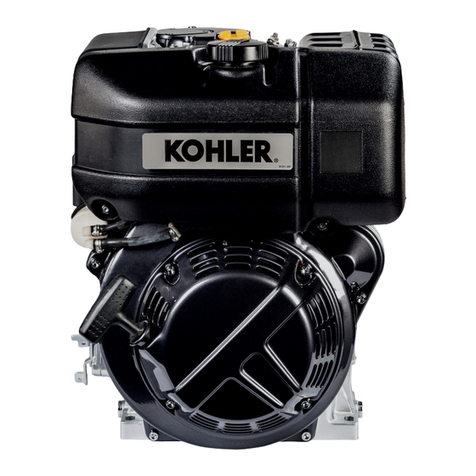
Kohler
Kohler KD15 440 Use & maintenance

Ametek
Ametek dunkermotoren GR Series Translation of the original assembly instruction
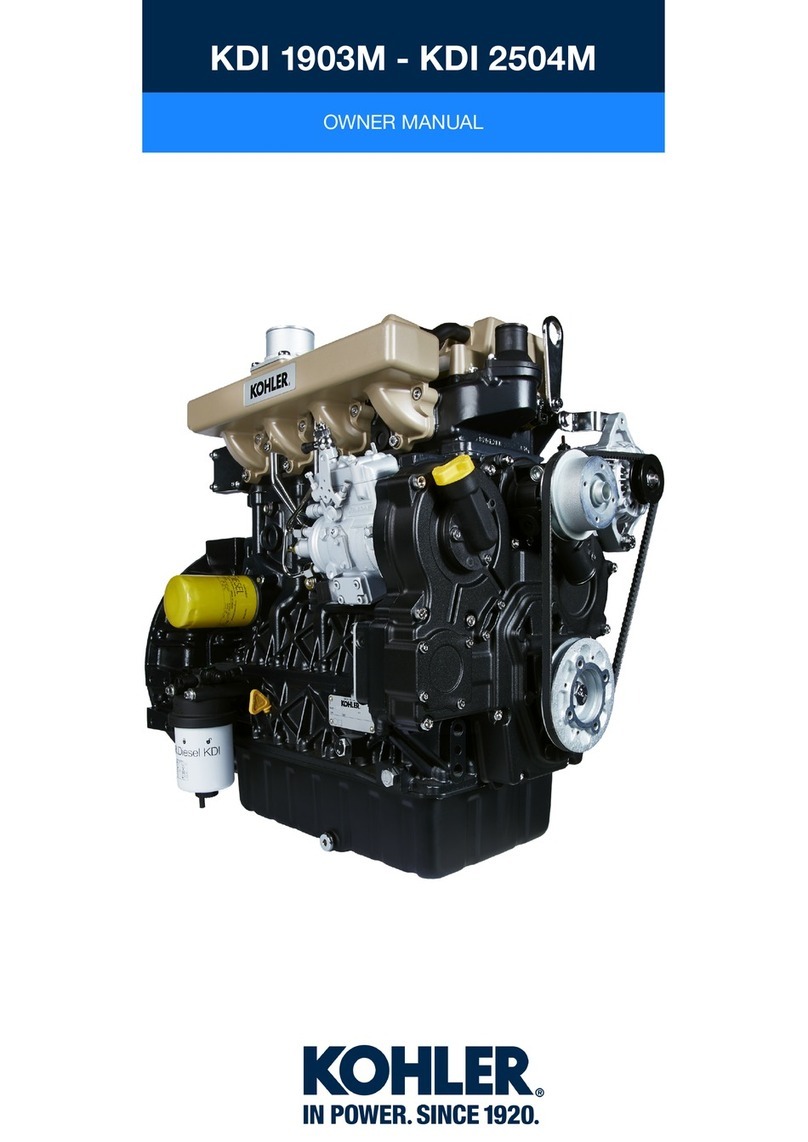
Kohler
Kohler KDI 1903M owner's manual
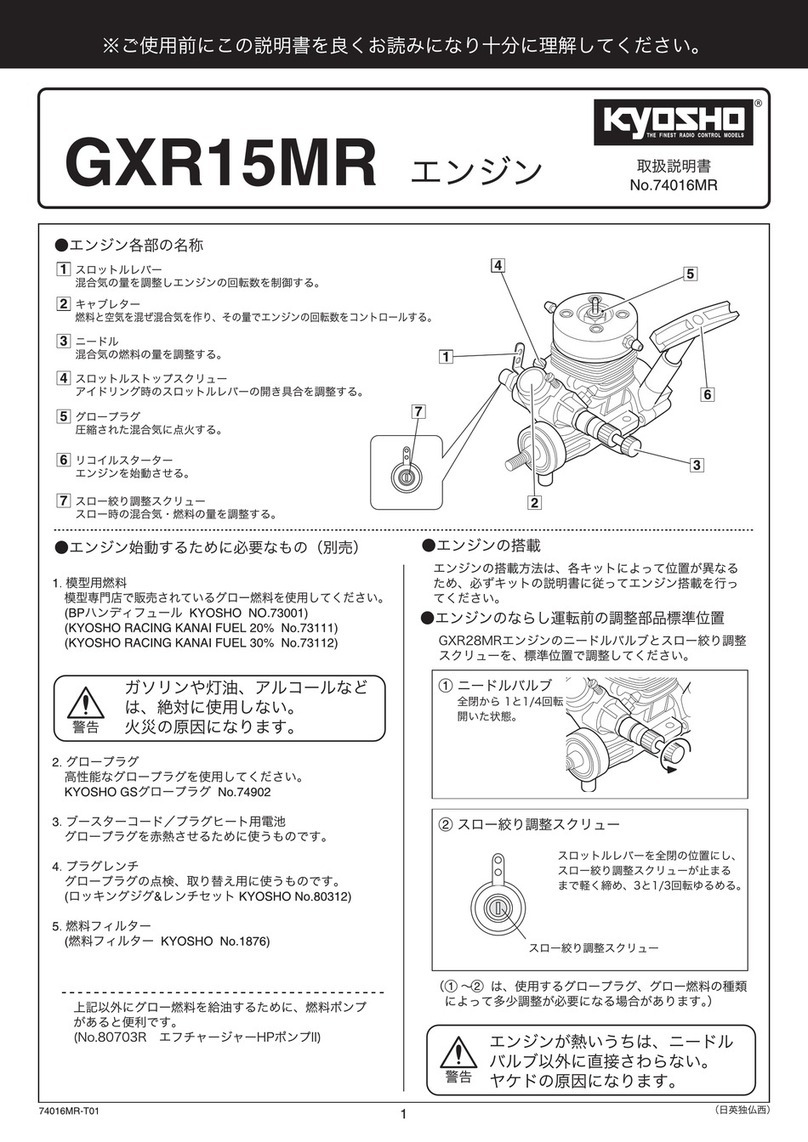
Kyosho
Kyosho GXR15MR instruction manual
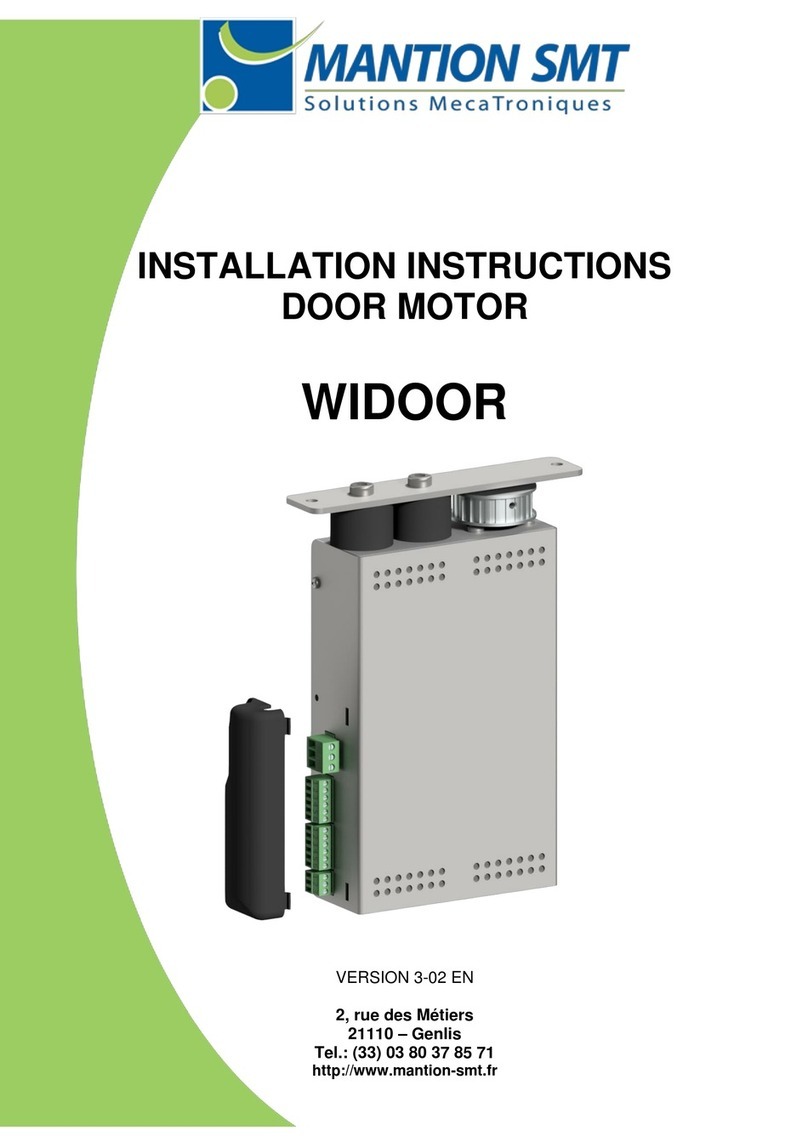
Mantion
Mantion WIDOOR installation instructions
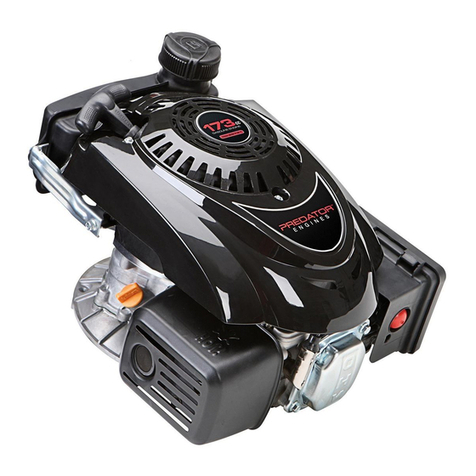
Predator Engines
Predator Engines 173cc Owner's manual & safety instructions
